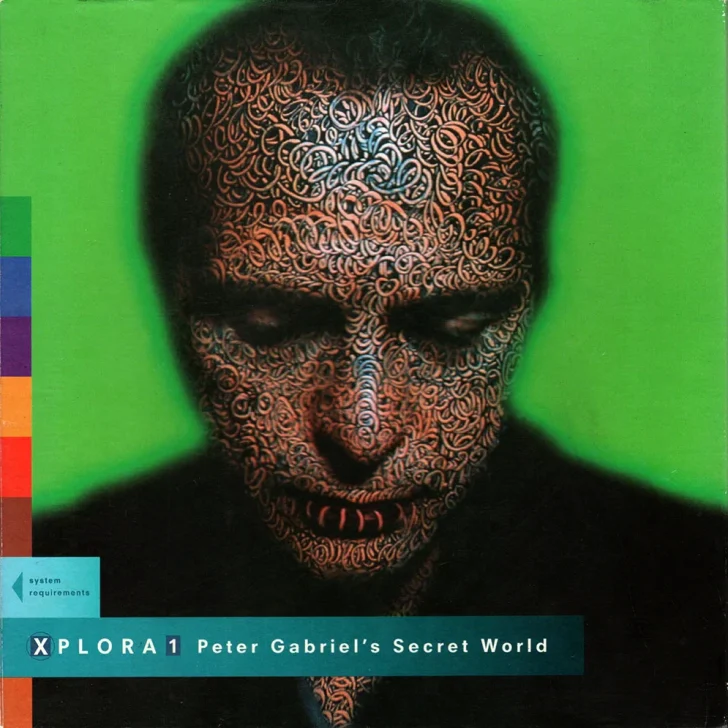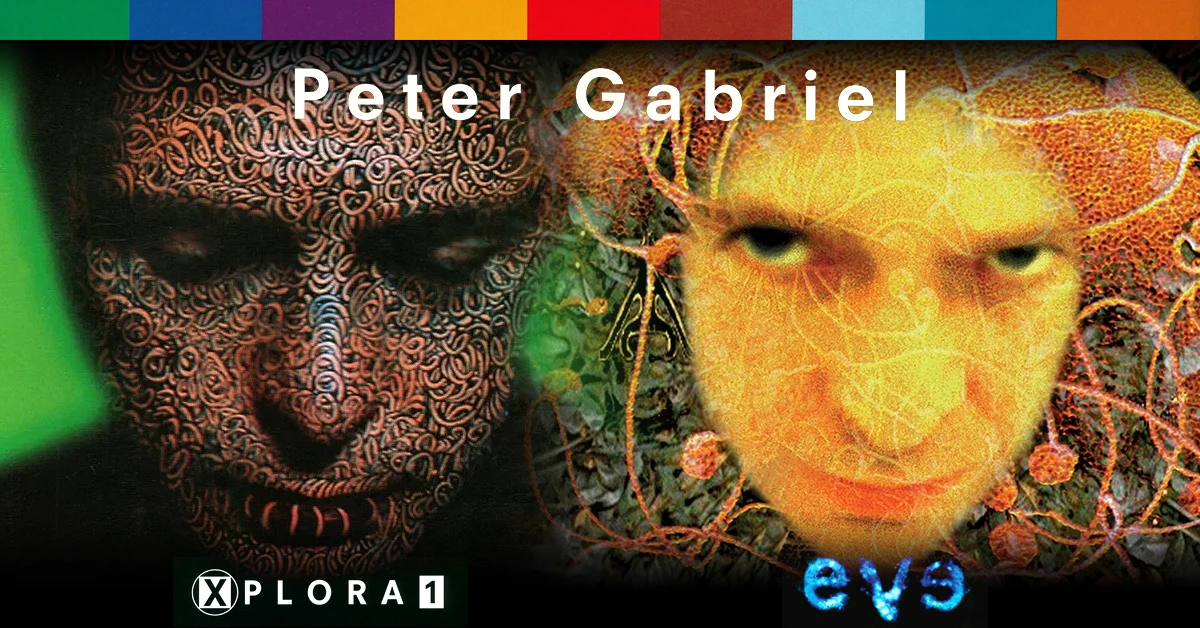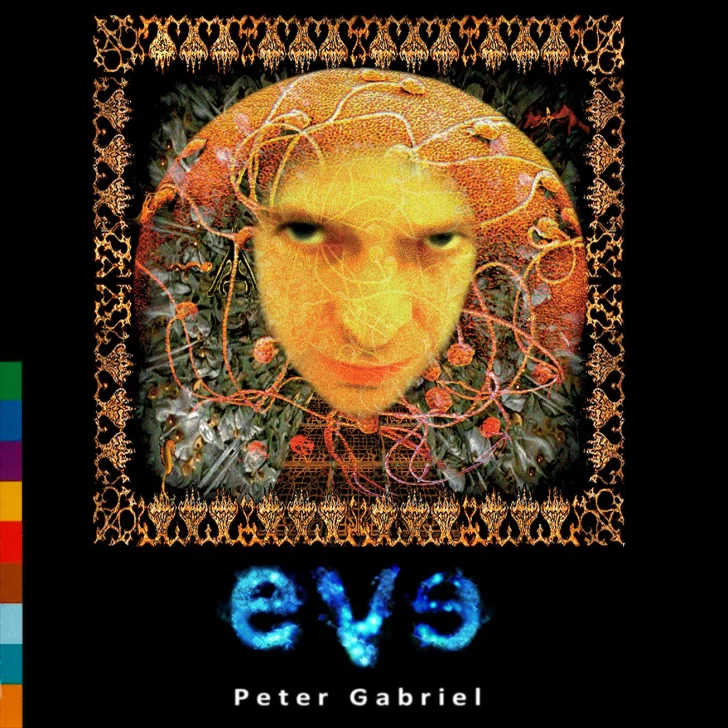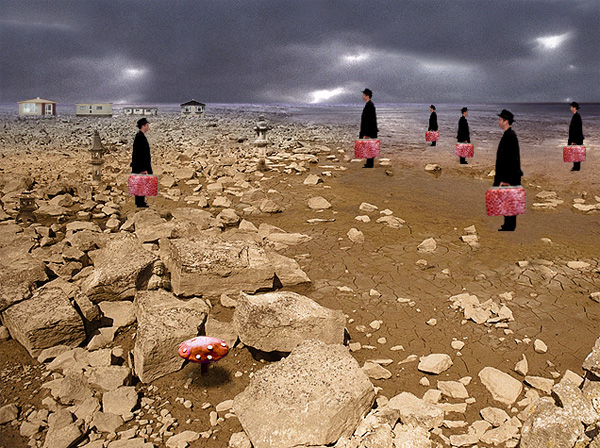- Article
- Read in 9 minutes
Peter Gabriel – Xplora1 and EVE (CD-ROM)
In 1993 and 1996, Peter Gabriel released two CD-ROMs with multimedia content. Some thirty years later, we take another look.
The multimedia big bang at Real World
In the 90s, after the end of the Secret World Live Tour, Peter Gabriel went very quiet. In particular, new music (the size of an entire album) was to wait until the year 2000.
However, Gabriel was not inactive because of this. In addition to all kinds of political and social activities, he creatively succumbed to the opportunities that the new digital media began to offer. Two CD-ROMs were published on which his music, his world view and his artistic interests were presented visually and interactively.
At the time, this was uncharted territory – and was subsequently taken up in one way or another by many other musicians. For a while, CDs liked to have a CD-ROM section on which the artists offered video clips, interviews or other additions to their album.
Gabriel had always loved not only making music, but also combining it with other art forms, which then permeated each other. Involving his audience and offering them choices for their experience was something that appealed to him. The multimedia technology was a perfect fit.
No wonder he embarked on the endeavour to create something with it.
A look back?
Unlike Gabriel’s entire music catalogue, the two CD-ROMs are hardly noticed today. The main reason for this is that they are no longer technically up to date with current platform technology. At best, they can still be run in the context of emulators, which can also be found on the Internet.
Nevertheless, it is worth taking another look at them some 30 years later. In addition to the new technical territory that Gabriel once again broke here, they are also thoroughly entertaining. Above all, however, they are a broad field in which Gabriel revealed much that occupied him and interested him – and which therefore also flowed into his music. To really immerse yourself in the thoughts and worlds of his pieces, what the two multimedia works present is not completely unimportant.
In the following, we will try to show a little of this. Also because the significance of some things only really becomes clear when we look back.
Xplora1: Peter Gabriel’s Secret World
(released 21 December 1993)

It was a certain Steve Nelson from the San Francisco-based company Brilliant Media who introduced Peter Gabriel to the possibilities of multimedia technology when he was releasing the US album. And Gabriel was quickly impressed. Brilliant Media was then responsible for the realisation, which was published by the specially created company Real World Multimedia.
Xplora1 is essentially a large knowledge playground where you can access all kinds of information about Gabriel, his music and his activities. There are four core areas:
● World Music (with the catalogue of Real World Records, musical instruments of the world, a tour of a WOMAD festival)
● Gabriel’s private room (with presentations about Witness, Amnesty International, Gabriel’s discography and private photos and Super8 clips from his childhood)
● The US album (with in-depth information on the song ideas, the song videos – if available – and the artwork for the song)
● Behind the Scenes (with a tour of the Real World Studios, recordings of the 1993 Grammy Awards and a reference to the Box Magazin fanzine)
Basically, what you experience is comparable to opening the web pages of an internet site. Some sections remain closed until you have found certain items somewhere and placed them in your suitcase. These then function like entry passes – and sometimes the items you are looking for are actually passes. But sometimes they are also something like a flower that can be picked.
In all these areas you can click, open, play and read various things. There are pictures, short videos (mostly of a documentary nature) or interactive elements to discover, such as exotic musical instruments that can be played. Of course, it is particularly exciting when you can remix Digging In The Dirt (at least a short version of it) or move around the Real World Studios site (and open some doors). And there are also some hidden features such as the ‘Lovebomb’.
Time and time again, PG will appear in the top left-hand corner of the screen with a video prompt, addressing the user directly and giving brief instructions on what is possible on the current page or what has been overlooked.
The CD-ROM is designed so that you can spend hours exploring. However, it soon becomes a little monotonous, as all you can really do is call up information. The experience is limited to clicking through the areas on offer. There isn’t really any kind of progression or success (apart from finding the key for some areas). It also reinforces the impression that Xplora1 is essentially an extended advertising vehicle for the US album and Real World Records.
Technically, everything is also very simple. Images and interfaces are pixelated, videos are tiny, music snippets are short. The user interface is always somehow understandable, but not always smooth. What was ground-breaking back then is now cold coffee and hardly fascinating. At least it has a great deal of nostalgic charm.
After the turn of the millennium, multimedia technology developed to such an extent that you could easily find something like Xplora1 on websites. In 1993, the concept was new and was offered at the highest technical level that home computers could implement. From today’s point of view, it’s rather cute. Aesthetically, however, it was well thought out and creative.
Xplora1 was first released in December 1993 for the Apple Macintosh with macOS, then in 1994 for Microsoft Windows and in 1995 for the exotic CD-i format from Philips and Sony. It was extremely successful and received 12 awards worldwide.
Peter Gabriel’s EVE
(released 31 December 1996)
Gabriel felt inspired by the success. In 1994, Xplora1 won all the prizes for interactive media of its kind and became the best-selling music CD-ROM in the world. An encouragement to continue along the path and try to achieve even more with the new technologies. The 1 in the title already hinted that more could be possible.
So the Real World Multimedia team set about creating a successor.
And indeed, EVE is something of a sequel to Xplora1. Many basic ideas have been adopted or further developed: Dividing the game into areas that you can enter, collecting items to unlock new sections or features, the ability to play around with song mixes. The suitcase motif has also been revisited. – This time, however, all of this no longer resulted in a large ‘info centre’, but was instead based on a fundamental narrative and a progression. In this sense, EVE really is much more of a computer game.
You follow the transformation of the world (symbolised in the game landscape) through the stages of mud, garden and industrialisation. This is intertwined with the search to become a united being again after the split into an Adam and an Eve. The three landscapes (plus a fourth) were each aesthetically designed by a visual artist and you can call up thoughts in them, especially on the subject of ‘people and their coexistence’ by philosophers, scientists, normal people and Peter Gabriel himself. Some of these thoughts are quite abstruse – but they are all thought-provoking.
The remix areas, where you can redo Gabriel’s songs, are also central. Hidden in each of the three landscapes are musical fragments that can be activated by uncovering / opening / triggering and then used for the remixes. There are always two working overviews for these: One that is more like a control panel, and one as a moving image. In both, the song fragments are displayed as animated objects, but in the moving image they come together to form a kind of music video of the song.
The more you discover and play with, the more the central landscape grows and changes, constantly developing the overall effect in a striking way. Sometimes you also have to complete small games of skill (smashing garden gnomes, catching insects), but these are always fun and should never be too demanding. You go through a world development, learn various things about social behaviour and are always accompanied by Gabriel’s music. In the end, you should actually manage to bring a united being back into an idyllic landscape.
EVE is divided into the following four development stages:
● Mud – music: Come Talk To Me | art: Yayoi Kusama
● Garden – music: Shaking The Tree | art: Helen Chadwick
● Profit – music: In Your Eyes | art: Cathy de Monchaux
● Paradise – music: Passion | art: Nils-Udo
Overall, EVE is much more of a gaming experience than Xplora1 with its more didactic sectionalisation. Everything here is creative and lively in its handling, much more aesthetic, humorous and sometimes slightly crazy. However, this also makes it a little confusing at times. In addition, you can only activate a limited number of elements on each screen, after which you have to move on. A return visit is therefore essential and can sometimes be a bit annoying. However, there is no real gaming experience with winning and failing. Here, too, the focus is on discovery – and something like carefree ‘wandering around’.
You can spend hours doing this in EVE. If you just want to advance the development of the world and the merging of Adam and Eve, much less, but if you try everything out, watch all the clips and information, then you have 22,000 photographs, 80 minutes of video material and 45 minutes of music (segments) at your disposal.
EVE was released on 31st Dezember 1996 for macOS and Windows 95
Assessment
Both CD-ROMs appear to be merely a side activity in Gabriel’s creative world, as they have (almost) nothing new to offer in terms of music. In fact, however, they are firmly embedded in his world of thought and expression of the mid-90s.
Many (even small) moments from Gabriel’s other works appear in the two multimedia works. Not least the element ‘suitcase’, which appears for the first time in the artworks by US and also plays a role in the Secret World Live Show.
In Xplora1, quotes from US song artworks or videos appear again and again. It is also characterised by US entire marketing design (as it also appears on the video documentary compilation All About Us – many film passages from it are reused). The aesthetics of the video for Lovetown (or vice versa – as you like) are also entirely EVE.
For OVO, the motif of the development of an Achaic world towards over-industrialisation is later taken up again. In addition, of course, the design art of Nils-Udo, which is used in the Real World Edition of the album.
And the Real World Recording Weeks, which ultimately lead to Big Blue Ball, are already present in Xplora1. The fact that the two CD-ROMs are full of music from Passion and US is abundantly clear and hardly needs to be mentioned. In general, they are obviously located in the context of world music. This continues to underpin Gabriel’s creations for a while and it is only with UP that he breaks away from it and treads other paths (which were then also clearly noticeable).
Gabriel’s fascination with science and its findings is also evident in the CD-ROMs, also beyond the realms of common knowledge. EVE offered a great deal of scope for this – even if it was thematically focussed on social psychology. Later, Gabriel’s interest was again expressed in the microscopic images in the Scratch My Back / New Blood project and then, of course, in the themes of the i/o songs Panopticom, Playing For Time, Olive Tree and perhaps others.
In this categorisation, the collaboration with visual artists should not be forgotten, which first appeared in US and is continued here, switching to photographs for UP in order to involve visual artists again for i/o. A field that Gabriel says he finds enormously exciting.
The idea of offering his songs for remixing did not leave Gabriel so quickly either. In the wake of UP, he offered an online mixing system called Noodle, which could be used to remix The Tower That Ate People (the platform is now sadly dead), and from 2008 he also released samples of the soundtracks of three older songs for the same purpose.
All in all, it can therefore be said that Xplora1 and EVE were not simply incidental side phenomena – they are an expression and part of the thoughts that occupied Gabriel for a long time – which he perhaps still carries around with him. In order to understand his understanding of himself and his art, it is therefore essential to take them into account.
Author: Thomas Schrage (November 2024)
Discuss the CDRoms in our forum in this thread.
Links
Xplora1
Unboxing and Playthrough Video
https://www.youtube.com/watch?v=EbF7dh8shpY
Playthrough:
https://www.youtube.com/watch?v=nfLGl9_5oGg
Edits of interesting parts of the game (17 min):
https://www.youtube.com/watch?v=y7EKnhIG6zY
Director Michael Coulson says:
https://michaelcoulson.typepad.com/
EVE
Unboxing Video
https://www.youtube.com/watch?v=UW3fI0DkehM
Playthrough:
https://www.youtube.com/watch?v=XGMLPAFGbDk
Director Michael Coulson says:
https://michaelcoulson.typepad.com/
A critical, but fair review:
https://www.korrupt.biz/





